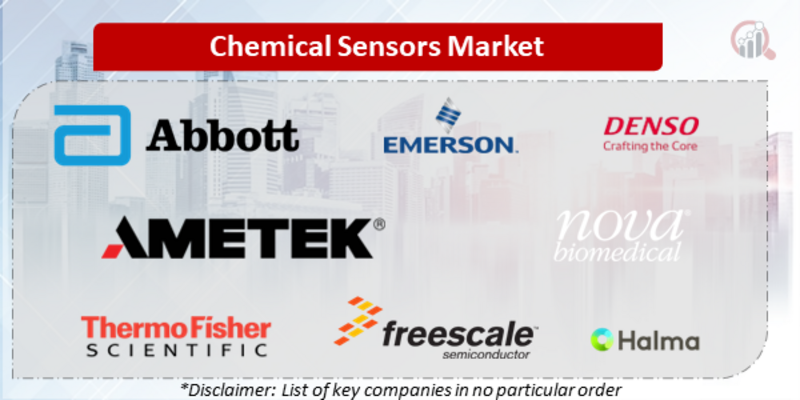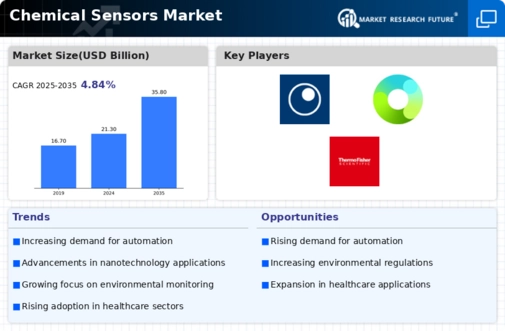Top Industry Leaders in the Chemical Sensors Market

The Chemical Sensors Market: A Landscape Analysis
The global chemical sensors market is a dynamic and rapidly growing space. This growth is driven by several factors, including increasing demand for environmental monitoring, advancements in medical diagnostics, and the burgeoning automation across various industries. However, navigating this competitive landscape necessitates a keen understanding of the key players, their adopted strategies, and the metrics for gauging market share.
Key Players
- Abbott Laboratories
- Emerson Electric Co.
- Denso Corporation
- Nova Biochemical Corp.
- Thermo Fisher Scientific Inc.
- AMETEK Inc.
- Alpha MOS
- Freescale Semiconductor Inc.
Strategies Adopted By Key Players:
- Product Differentiation: Continuous innovation and development of new sensor technologies, such as miniaturized, low-power, and multi-functional sensors, are key to differentiation.
- Strategic Partnerships: Collaborations with research institutions, universities, and startups enable access to cutting-edge technologies and expertise.
- Market Expansion: Entering new geographic markets and catering to specific application segments with tailored solutions is crucial for expanding market reach.
- Vertical Integration: Some companies are vertically integrating their operations, gaining control over the entire value chain from material sourcing to sensor development and production.
- Focus on Sustainability: Developing eco-friendly and energy-efficient sensors is gaining traction due to rising environmental concerns.
Factors for Market Share Analysis:
- Product Portfolio Diversification: Companies with a wider range of sensors catering to diverse applications tend to hold a stronger market position.
- Technological Expertise: Continuous innovation in sensor technology and deployment of advanced features like miniaturization and integration with IoT platforms are crucial differentiators.
- Geographical Reach: Presence in key growth markets like Asia Pacific and Latin America, alongside established markets like North America and Europe, grants a wider customer base and market share dominance.
- Distribution Channels and Partnerships: Robust distribution networks and strategic partnerships with industry players ensure easier product reach and market penetration.
- Brand Reputation and Customer Loyalty: A strong brand image built on quality, reliability, and excellent customer service fosters customer loyalty and repeat business, contributing to market share.
New and Emerging Technologies:
- Biomimetic Sensors: These sensors mimic the sensing mechanisms of biological organisms, offering highly sensitive and selective detection capabilities for various chemicals.
- Graphene-based Sensors: Graphene's unique properties like high conductivity and surface area enable highly sensitive and fast-responding gas and biomolecule sensors.
- Microfluidic Sensors: These miniaturized systems integrate microfluidic channels and sensors for on-site and real-time chemical analysis, finding applications in environmental monitoring and medical diagnostics.
Latest Company Updates
Abbott Laboratories:
- October 2023: Announced a collaboration with the University of California, San Diego to develop next-generation biosensors for continuous glucose monitoring.
- November 2023: Received FDA approval for the FreeStyle Libre 3 system, a continuous glucose monitoring sensor with improved accuracy and wear time.
- December 2023: Presented research on a new electrochemical sensor for measuring blood alcohol content at a conference on biosensors.
Emerson Electric Co.:
- October 2023: Launched a new line of gas sensors for industrial applications, featuring improved sensitivity and long-term stability.
- November 2023: Announced a partnership with Microsoft to develop cloud-based sensor data management solutions for the industrial sector.
- December 2023: Acquired a leading manufacturer of optical gas sensors, expanding its portfolio of environmental monitoring technologies.









